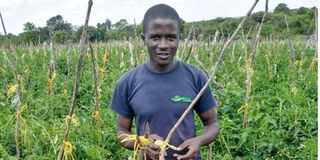Staking tomato plants: When and how to do it

Staked tomatoes on a farm in Kajiado. Staking tomato plants helps in keeping the crops off the ground ensuring they remain clean and curb diseases.
What you need to know:
- Training or staking refers to the process of guiding the plants as they grow along a support system.
- Staking tomato plants helps in keeping the crops off the ground ensuring they are clean to curb diseases.
- It is easier to spray supported plants to control pests and diseases as this allows proper crop coverage.
- While pruning, one should ensure the tools used are disinfected to prevent the spread of diseases.
This week, the third since we transplanted, we focused on training and supporting Moses’ tomatoes. The two practices are key in improving aeration of the plants.
Training or staking refers to the process of guiding the plants as they grow along a support system.
It is done by tying the seedlings on stakes using manila or sisal twines. Tomato plants must be supported as early as possible to avoid the crop from bending.
Training should be done 3-4 weeks after transplanting and repeated depending on the vegetative nature of the plant.
But before staking, there are things that you must do. We scouted the crops to check if they are ready for staking.
We then acquired the staking materials, the posts and strings, from a reliable source and erected them in a way that does not cause damage to tomato roots.
If they had been used in previous crop, disinfect them to avoid chances of spreading diseases to young seedlings. For our cases, we did not buy poles but pruned those on the border trees of Moses farm.
Once we erected the poles, we also disinfected the strings. We then tied the seedlings loosely using the string on the poles.
Staking tomato plants helps in keeping the crops off the ground ensuring they are clean to curb diseases.
This also reduces losses from fruit rot as the crop touches the soil and sun scalding when the fruits are not shaded by the crop foliage.
It is easier to spray supported plants to control pests and diseases as this allows proper crop coverage.
Weed control
Supported crops are also easier to prune and harvest compared to those on the ground.
An alternative to staking is mulching. You can mulch the plant to prevent the fruits from touching the ground.
However, sometimes the mulch can act as a hiding or breeding ground for pests and diseases, especially during the rainy season.
The variety Moses planted is determinate, which means it has short to medium length vines. We shall prune it to remain with two or three mature branches.
Pruning should be done early in the morning. While pruning, one should ensure the tools used are disinfected to prevent the spread of diseases.
Pruning is best done when the crop is two months old. While pruning, remove shoots when they are less than 4 inches long as this prevents injuring the plant.
I demonstrated to Moses how to remove the suckers by grasping it between the thumb and the second finger and bending it until it breaks.
Since Kajiado is experiencing cold weather conditions and short rains, our tomatoes are likely to be affected by fungal diseases such as blight.
We have thus been spraying on them a copper-based chemical to ensure our crop is protected.
On the other side, signs of Tuta absoluta were sported in a few of the leaves, but we controlled them.
Moses is keeping records of all the activities taking place on the farm. Weeds are emerging thus we shall focus on weed control in our next article.





